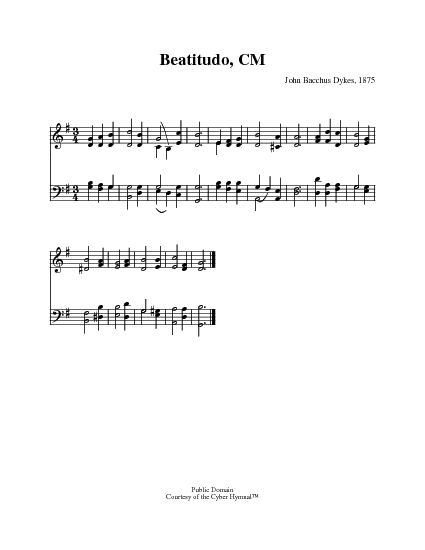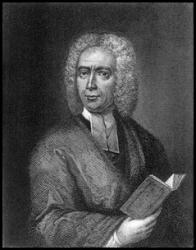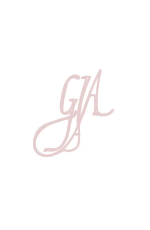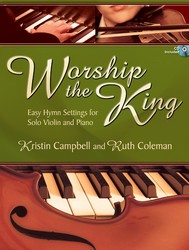- |
User Links
The Glories of Redemption

Father, how wide Thy glory shines
Author: Isaac WattsPublished in 306 hymnals
Printable scores: PDF, MusicXMLAudio files: MIDI
Representative Text
1 Father, how wide Thy glories shines.
How high Thy wonders rise!
Known through the earth by thousand signs,
By thousands through the skies.
2 Those mighty orbs proclaim Thy power;
Their motions speak Thy skill:
And on the wings of every hour
We read Thy patience still.
3 But when we view Thy strange design
To save rebellious worms,
Where vengeance and compassion join
In their divinest forms:
4 Our thoughts are lost in reverent awe;
We love and we adore;
The first archangel never saw
So much of God before.
5 Here the whole Deity is known,
Nor dares a creature guess
Which of the glories brightest shone,
The justice or the grace.
6 Now the full glories of the Lamb
Adorn the heavenly plains;
Bright cherubs learn Immanuel’s name
And try their choicest strains.
7 O may I bear some humble part
In that immortal song!
Wonder and joy shall tune my heart,
And love command my tongue.
AMEN.
Source: The A.M.E. Zion Hymnal: official hymnal of the African Methodist Episcopal Zion Church #24
Author: Isaac Watts
 Isaac Watts was the son of a schoolmaster, and was born in Southampton, July 17, 1674. He is said to have shown remarkable precocity in childhood, beginning the study of Latin, in his fourth year, and writing respectable verses at the age of seven. At the age of sixteen, he went to London to study in the Academy of the Rev. Thomas Rowe, an Independent minister. In 1698, he became assistant minister of the Independent Church, Berry St., London. In 1702, he became pastor. In 1712, he accepted an invitation to visit Sir Thomas Abney, at his residence of Abney Park, and at Sir Thomas' pressing request, made it his home for the remainder of his life. It was a residence most favourable for his health, and for the prosecution of his literary… Go to person page >
Isaac Watts was the son of a schoolmaster, and was born in Southampton, July 17, 1674. He is said to have shown remarkable precocity in childhood, beginning the study of Latin, in his fourth year, and writing respectable verses at the age of seven. At the age of sixteen, he went to London to study in the Academy of the Rev. Thomas Rowe, an Independent minister. In 1698, he became assistant minister of the Independent Church, Berry St., London. In 1702, he became pastor. In 1712, he accepted an invitation to visit Sir Thomas Abney, at his residence of Abney Park, and at Sir Thomas' pressing request, made it his home for the remainder of his life. It was a residence most favourable for his health, and for the prosecution of his literary… Go to person page >Text Information
| First Line: | Father, how wide Thy glory shines |
| Title: | The Glories of Redemption |
| Author: | Isaac Watts |
| Meter: | 8.6.8.6 |
| Language: | English |
| Copyright: | Public Domain |
Notes
Father, how wide Thy glory shines. J. Watts. [Glory of God and Salvation of Men.] First published in his Horae Lyricae, 1705, in 9 stanzas of 4 lines, and headed "God glorious and Sinners saved," As early as 1738-1741 J. Wesley included it in an abbreviated form in his Psalms & Hymns, and it was subsequently given about 1800, in the Wesleyan Hymn Book. Its early use in the Church of England was furthered by E. Conyers, De Courcy, A. M. Toplady, and others. Its use, but usually in an abbreviated form, is extensive in Great Britain and America. Full original text in modern editions of the Horae Lyricae, and Watts's Works.
--John Julian, Dictionary of Hymnology (1907)
Tune
BEATITUDOComposed by John B. Dykes (PHH 147), BEATITUDO was published in the revised edition of Hymns Ancient and Modern (1875), where it was set to Isaac Watts' "How Bright Those Glorious Spirits Shine." Originally a word coined by Cicero, BEATITUDO means "the condition of blessedness." Like many of Dykes's…
NOEL (Mason)


 My Starred Hymns
My Starred Hymns






